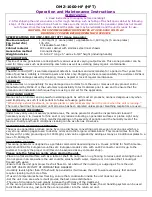
Outdoor Unit
Purging Air And Checking Gas Leakage
� WARNING------------------------
• Do not mix any substance other than the specified refrigerant (R32) into the refrigeration cycle.
• When refrigerant gas leaks occur, ventilate the room as soon and as much as possible.
• To prevent air pollution, a vacuum pump should be used for air purging wherever possible.
• If using additional refrigerant, perform air purging from the refrigerant pipes and
indoor unit using a vacuum pump, then charge additional refrigerant.
• Use a hexagonal wrench to operate the stop valve rod.
• All refrigerant pipe joints should be tightened with a torque wrench at the
specified tightening torque.
1) Connect projection side (on which pin is pressed) of charging hose (which comes from gauge
manifold) to gas stop valve's service port.
2) Fully open gauge manifold's low-pressure valve (Lo) and completely close its high-pressure valve (Hi).
(High-pressure valve subsequently requires no operation.)
3) Do vacuum pumping and make sure that the compound pressure gauge reads ---0.1 MPa (-76cmHg) *1.
4) Close gauge manifold's low-pressure valve (Lo) and stop vacuum pump.
(Keep this state for a few minutes to make sure that the compound pressure gauge pointer does not swing back.) *2.
5) Remove valve cap from liquid stop value and gas stop valve.
6) Turn the liquid stop valve's rod 90 degrees counterclockwise with a hexagonal wrench to open valve. Close it after 5 seconds, and check for gas leakage.
Using soapy water, check for gas leakage from indoor unit's flare and outdoor unit's flare and valve rods.
After the check is complete, wipe all soapy water off.
7) Disconnect charging hose from gas stop valve's service port, then fully open liquid and gas stop valves. (Do not attempt to turn valve rod beyond its stop.)
8) Tighten valve caps and service port caps for the liquid and gas stop valves with a torque wrench at the specified torques.
*1. Pipe length vs. vacuum pump run time
Pipe length
I
Up to 15m
More than 15m
Run time
Not less than 10 min. I Not less than 15 min.
•2. If the compound pressure gauge pointer swings back,
refrigerant may have water content or a loose pipe joint
may exists. Check all pipe joints and retighten nuts as
needed, then repeat steps 2) through 4).
Wiring
• For inter-unit wires connections, see
(
INDOOR UNIT).
GI
WIRING).
�::;""'�---
• When connecting the connection wires to the terminal block using a single core wire, be sure to perform curling.
Problems with the work may cause heat and fires.
Wire
retainer
• Regarding the interconnecting
and power cables.
� WARNING ---
Never use short cables for
connecting end of conductor to
each other.
lill
Drain Work
1) Use the@drain socket for drainage.
-
t
--
t
�
� �
QGood
XWrong
Stripping wire at terminal block
, Precaution to be taken for power supply wiring.
• When using stranded wires, make sure to use a round crimp-style terminal for connection to
the power supply terminal block. Place the round crimp-style terminals on the wires up to
the covered part and secure in place.
2) When attaching the@drain socket to the bottom frame, make sure the connect the drain hose to the drain socket first.
3) If the drain port is covered by a mounting base or floor surface, place additional foot bases of at leaset 30mm in height under the outdoor unit's feet.
4) In cold areas, do not use a drain hose with outdoor unit. (Drain water may freeze. impairing heating performance.)
Strip wire end to this point.
Round crimp
style terminal
Stranded wire
m--
□l'lllnport
_,r
·-�-�
®Draln"°""81
}
�
::!:.�l::!)ommerci•ny,
10



































